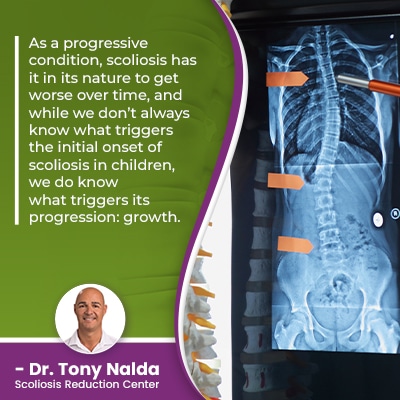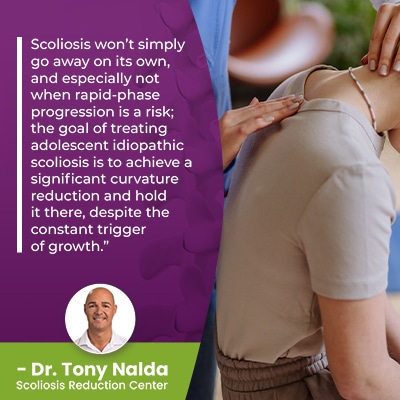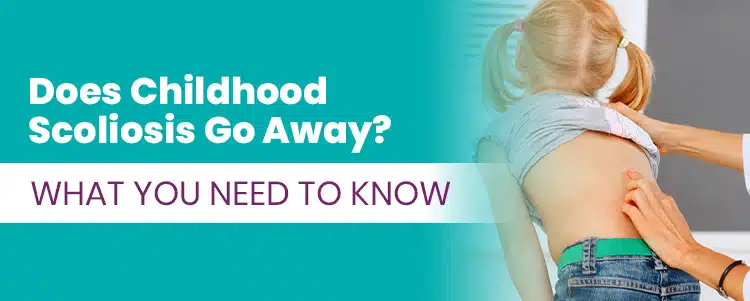Scoliosis doesn’t go away, as in a cure, because as a progressive condition, scoliosis has it in its nature to get worse over time. Scoliosis can be highly treatable, particularly with early detection and a proactive conservative treatment plan. When it comes to childhood scoliosis, the danger is rapid-phase progression; continue reading to find out why.
There are different types of scoliosis, and although the condition affects children the most, it also affects adults. The most common type of childhood scoliosis is adolescent idiopathic scoliosis (AIS), and scoliosis requires proactive treatment to go away.
As there are different types of childhood scoliosis, let’s start with the differences.
Scoliosis By Age
Scoliosis affects all ages from infants to the elderly and every age in between, and the condition involves the development of an unnatural sideways-bending spinal curve that also rotates.
When scoliosis is diagnosed, part of the process involves further classifying conditions based on important variables, and these variables shape the crafting and customization of treatment plans.
An important classification point is patient age, and this is especially important in terms of progression and pain.

As a progressive condition, scoliosis has it in its nature to get worse over time, and while we don’t always know what triggers the initial onset of scoliosis in children, we do know what triggers its progression: growth.
Growth and development is what makes scoliosis get worse, so young patients who have not yet reached skeletal maturity are facing the constant trigger of growth.
So in childhood scoliosis, we know a focus of treatment is counteracting the condition’s progressive nature.
Patient age is also important in terms of pain because scoliosis doesn’t become a compressive condition until skeletal maturity has been reached, and it’s compression of the spine and its surrounding muscles and nerves that causes the majority of condition-related pain.
So patient age also tells me whether or not pain management is likely to be needed as a focus of treatment, and whether or not rapid-phase progression is a risk.
In children, the main effect of scoliosis is postural deviation, and in adults, it’s pain: back pain and pain that radiates into the extremities due to nerve compression.
Let’s now explore some characteristics of the different types of childhood scoliosis.
Congenital Scoliosis
Cases of congenital scoliosis are rare, affecting approximately 1 in 10,000, and babies are born with the condition because it involves a malformed spine that develops in utero.
Oftentimes, this can involve the vertebrae (bones of the spine) being misshapen, or vertebral bodies failing to separate, instead becoming fused together as one solid bone.
Babies born with congenital scoliosis need comprehensive assessment and monitoring for other malformed parts and/or systems within the body.
Congenital scoliosis tends to get worse with growth, and treatment involves modifying plans to address the unique challenges associated with patients of such a young age.
Sometimes a combination of physical therapy and casting can help, and sometimes, surgery is required.
Infantile Scoliosis
Infantile scoliosis is diagnosed in children between the ages of 6 months and 3 years old, and this type of scoliosis is idiopathic, meaning not clearly associated with a single-known cause.
Some cases of infantile scoliosis resolve on their own, but there is no way of knowing which will resolve, and which will progress with growth, so being proactive with treatment can be beneficial.
Infantile scoliosis is likely to get worse with growth, and treatment can involve a combination of gentle chiropractic care, physical therapy, and corrective bracing.
Early-Onset Juvenile Scoliosis
Early-onset juvenile scoliosis is diagnosed between the ages of 3 and 10 years old, and this is the age group treatment can make the most difference in.
In this type, continued progression is more likely, but being able to diagnose and treat the condition prior to the first significant pubescent growth spurt means being able to make a big impact.
To treat early-onset juvenile scoliosis, I integrate chiropractic care, physical therapy, corrective bracing, and rehabilitation.
The best time to start treatment is while scoliosis is mild, prior to progressing significantly, so early detection can be beneficial, but nothing guarantees treatment success.
Adolescent Idiopathic Scoliosis
Adolescent idiopathic scoliosis diagnosed between the ages of 10 and 18 is the most prevalent type of scoliosis, and this age group is the most at risk for rapid-phase progression due to the rapid and unpredictable growth spurts associated with puberty.
Scoliosis introduces a lot of uneven forces to the body, and they can disrupt its overall symmetry and cause postural changes.
When it comes to scoliosis in adolescents, oftentimes the earliest signs are uneven shoulders and hips.
Additional postural changes associated with adolescent idiopathic scoliosis can include:
- Uneven shoulder blades
- The development of a rib arch
- An uneven waistline
- Arms and legs that appear to hang at different lengths
Additional signs to watch for can include changes to balance, coordination, gait, and clothing can suddenly seem ill-fitting due to related postural changes.

Scoliosis won’t simply go away on its own, and especially not when rapid-phase progression is a risk; the goal of treating adolescent idiopathic scoliosis is to achieve a significant curvature reduction and hold it there, despite the constant trigger of growth.
As adolescent idiopathic scoliosis is the condition’s most-prevalent type, let’s focus on the topic of AIS treatment.
Treating Adolescent Idiopathic Scoliosis
As mentioned, when it comes to making scoliosis go away, as a progressive condition, there is no curing scoliosis, but it can be highly treatable.
While early detection doesn’t guarantee treatment success, it does increase its likelihood; scoliosis only gets more complex to treat as it progresses, which is why being proactive with treatment can be so beneficial.
When treating adolescent idiopathic scoliosis, close monitoring for progression and how the spine is responding to growth and treatment is key.
I order X-rays as needed to see how the spine is responding and adjust treatment plans accordingly.
Here at the Scoliosis Reduction Center®, my patients benefit from a proactive conservative scoliosis treatment plan; I want to start treatment as close to the time of diagnosis as possible because that’s when conditions are at their mildest and the scoliosis is the simplest to treat.
Small curves are less complex to treat than large curves, and as scoliosis progresses, the size of the scoliotic curve is increasing, as are the condition’s uneven forces, and their effects.
Progression makes the spine increasingly rigid, and that can make it less responsive to treatment, and difficult for some patients to perform certain therapeutic exercises as part of treatment.
As a structural spinal condition, the main way to address scoliosis is on a structural level, and I work towards this in the form of a curvature reduction achieved through condition-specific chiropractic care.
A series of techniques and manual adjustments can work towards adjusting the position of the curve’s most-tilted vertebrae at its apex, back into alignment with the rest of the spine.
Once I start to see structural results, I can shift the focus to increasing core strength so the spine’s surrounding muscles are strengthened and better able to support the spine, and physical therapy and scoliosis-specific exercises can also address any related muscle imbalance, improve posture, and activate certain areas of the brain for improved brain-body communication.
Corrective bracing is particularly effective on growing spines so is a common facet of treatment for childhood scoliosis, and further stabilizing and healing the spine involves continued chiropractic care and a series of custom-prescribed home exercises to rehabilitate the spine from home.
Conclusion
So does childhood scoliosis go away? The answer is complex because although it can, particularly in infantile scoliosis, it does so rarely, and every case is unique.
When it comes to childhood scoliosis diagnosed during adolescence, continued progression into maturity is likely because of the rapid and unpredictable growth spurts of puberty.
As there is no definitive means by which we can determine which cases of childhood scoliosis will resolve on their own, and which will progress with time, growth, and maturity, it’s best to be proactive with treatment because as a progressive condition, scoliosis is virtually guaranteed to get worse at some point.
In the majority of childhood scoliosis cases, where a scoliosis is at the time of diagnosis is not indicative of where it will stay; only proactive treatment can work towards counteracting the condition’s progressive nature.
So what you need to know about childhood scoliosis is that it should always be taken seriously, even when mild, because mild scoliosis can easily progress to moderate, severe, and very severe.
The best way to minimize the effects of scoliosis is to treat it proactively, and here at the Center, my patients benefit from a proactive treatment response that works towards preserving long-term spinal strength and function.




